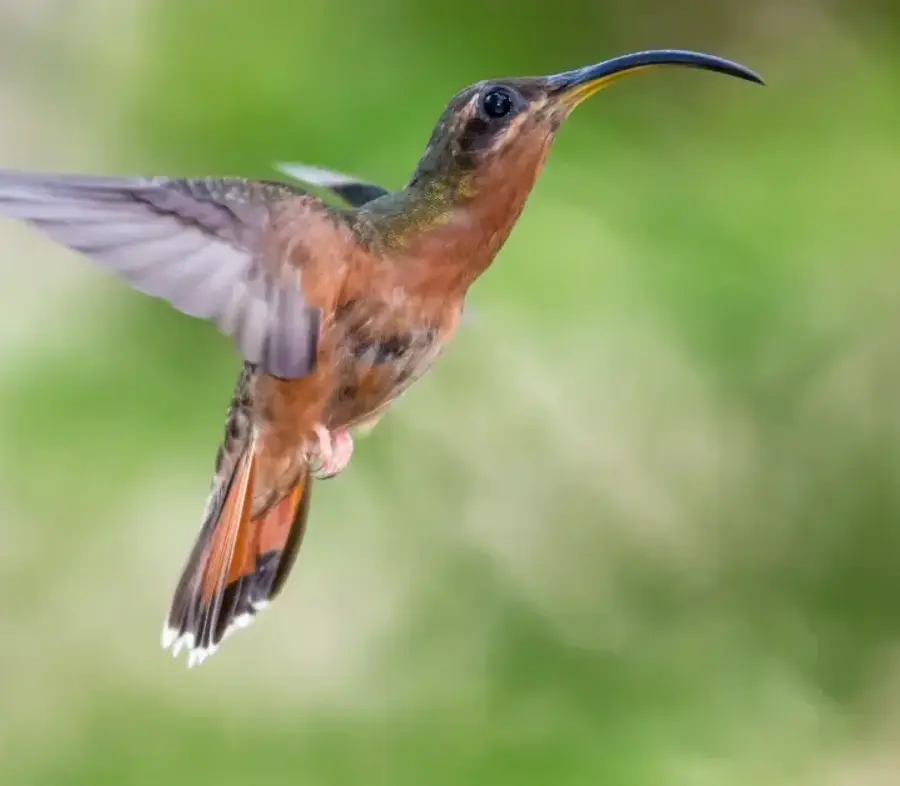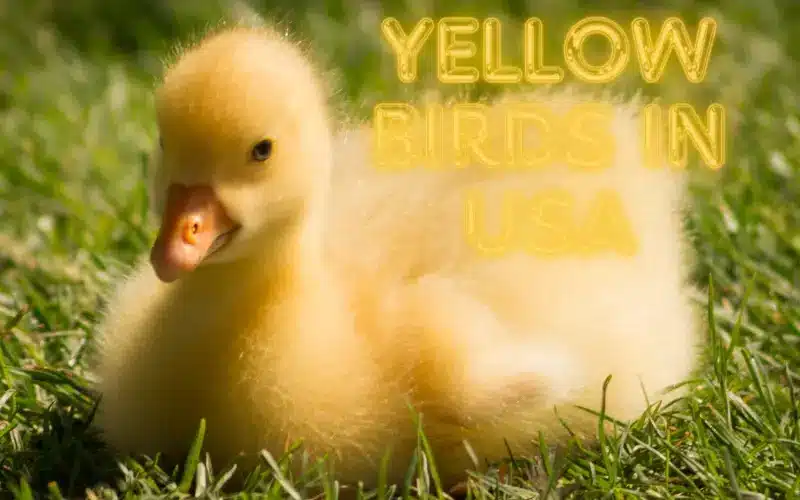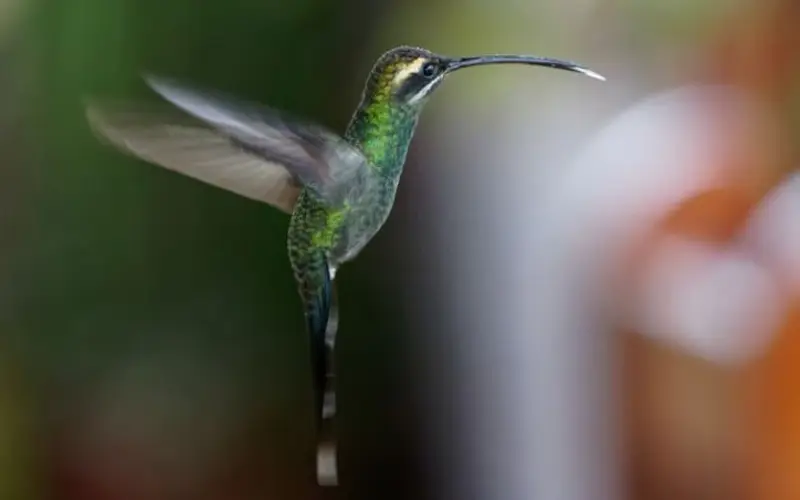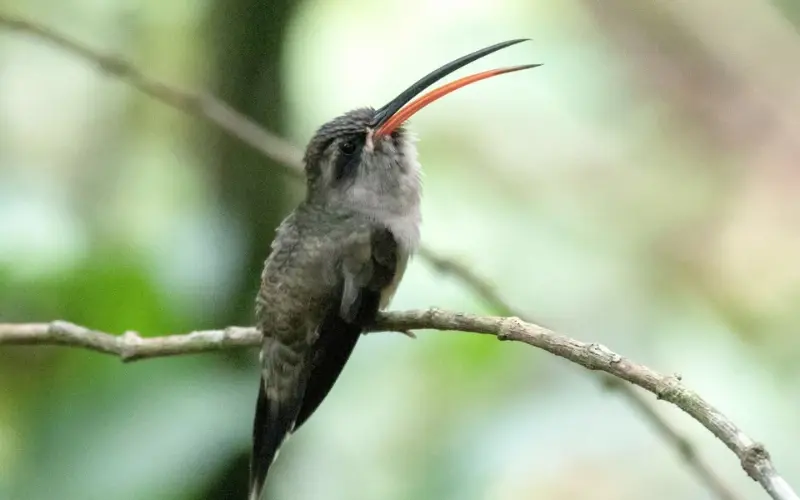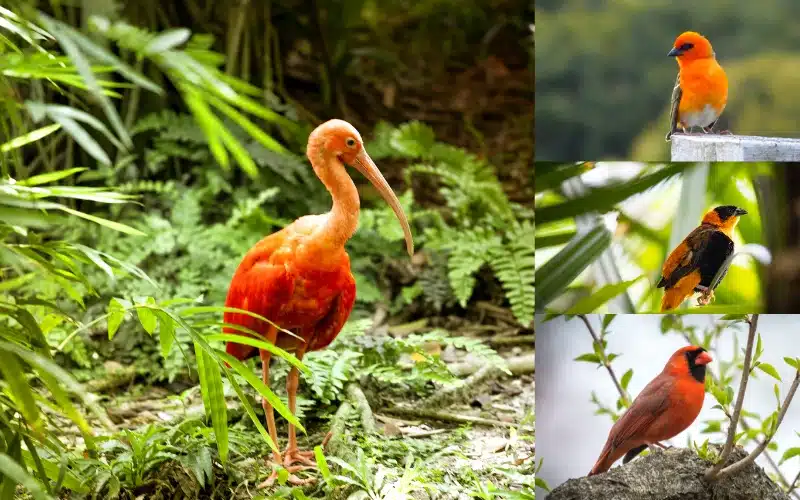The Rufous-breasted hermit hummingbird is a small hummingbird found in tropical South America. With an average body length of only 8–9 cm and a weight of 2–3 g, it is one of the smallest hummingbird species. Despite its small size, the rufous-breasted hermit exhibits striking plumage and interesting behaviors that make it a favorite among bird watchers.
Physical description
As the name suggests, the rufous-breasted hermit has red or gray underparts and breasts. The back and top of the head are bright green, while the tail is mainly rufous with black tips. The bill is long, thin, and curved downwards. Males have characteristic gray cheeks and throat. Females lack this distinct facial plumage and are generally less vibrantly colored on the underside. Young adults look like women.
Classification and Evolutionary History
The rufous-breasted hermit is one of more than 300 species of hummingbirds found in the United States. It is part of the hermit subfamily (Phaethornithinae) of dull-colored woodland hummingbirds with long corollas and blunt bills adapted to access nectar from flowers. The Rufous-breasted hermit is the only member of the Glaucis genus.
Fossil evidence suggests that hummingbirds have been present in South America for over 30 million years since the Oligocene. Modern hummingbirds are thought to have undergone rapid speciation and adaptation during the uplift of the northern Andes Mountains. Different hummingbird species evolved to make use of new floral resources and habitats as they became accessible. The Rufous-breasted hermit emerged as a tropical forest species that feeds on tall, tubular flowers.
Also Read: Birds in USA
Distribution and Habitat
The Rufous-breasted hermit is found along the northern coast and Amazon basin of South America. Its range includes parts of Colombia, Venezuela, Guyana, Suriname, French Guiana, Brazil and Peru. It occupies tropical lowland rainforests, forest edges, and adjacent semi-open areas such as orchards and other vegetation.
Population and conservation status
The IUCN Red List lists the rufous-breasted hermit as a species of least concern due to its extensive range in the Amazon. However, some local population declines have been noted, particularly in Brazil, where habitat loss due to urbanization The overall population is believed to be declining but not yet endangered or on the verge of becoming endangered. Maintaining the large tracts of tropical forest in which the species lives will be critical to its long-term survival.
Diet / Feeding

Like all hummingbirds, the rufous-breasted hermit subsists primarily on nectar taken from a variety of blooming flowers and plants. Some favorite food sources are flowers of the Heliconia genus and epiphyte vines in the Drymonia genus. The long curved bill of the Rufous-breasted hermit allows it to access nectar from flowers with corollas of the same shape and length that other birds and pollinators cannot reach.
In addition to nectar, the rufous-breasted hermit supplements its diet with small insects such as gnats, aphids, and spiders. Insects provide an additional source of protein. Foraging for insects involves flying quickly around plants and catching prey in mid-air or collecting it directly from leaves and branches.
Unique behaviour
One of the most interesting aspects of the Rufous-breasted hermit is its breeding behavior. Unlike most hummingbird species that nest in isolation, the Rufous-breasted Hermit is communal, meaning more than one bird will contribute to building and maintaining the same nest. In Primera Cruz, Brazil, more than a dozen communal nests were documented, two of which contained more than 100 eggs. This communal behavior is thought to provide defensive advantages against nest predators that live in large nests that frighten many birds.
Another unusual behavior is the rufous-breasted hermit’s use of its long bill to access certain food sources. The apparent downward curve of the bill is an adaptation for stealing nectar from the nests of social wasps. The hermit hovers near an active wasp nest and uses its bill to extract nectar from the outside of the paper. This risky behavior sometimes results in the hermit being chased or stung in the face by resident wasps defending the nest.
Rufous-breasted Hermit Relationship with humans
The rufous-breasted hermit‘s bright plumage and vigorous flight make it a favorite among bird watchers in the Neotropics. It makes regular visits to feeders and flower gardens. It offers close-up viewing and photography opportunities for bird enthusiasts, which is favored given the hummingbird’s general preference for the forest canopy.
The hermit is also important in the pollination network of plants. Various tropical plants have evolved corolla shapes and sizes that specifically match the hermit’s bill structure and pollination ability. By gaining access to certain flowers that only it can reach, the hermit completes the important tasks of pollination. This interdependent plant and pollinator relationship reflects the broader ecosystem services provided by the species.


